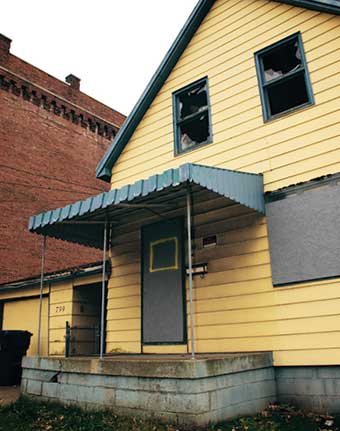A Poverty Plan
by George Sax

“The poor you have always with you,” the New Testament tells us (at Matthew 26:11), but for the more than 150 people who gathered in a meeting room of Buffalo’s Olmsted Center for Sight on Main Street last Friday, this admonition was definitely not the theme of their discussions. The attendees, representing 75 area anti-poverty groups, were intent on examining various potential strategies and programs to combat poverty in Western New York.
Friday’s meeting was the third annual edition of the Buffalo Poverty Research Workshop. The clear tenor of the meeting was that there is nothing inevitable about the level of poverty in the country—currently about 15.1 percent—and that reducing it substantially is eminently doable.
From the start, Megan Connelly, director of programs at the Partnership for the Public Good, said in an interview this week, one of the organizers’ goals has been “bridging the gap” between the academic world and community groups fighting poverty in order “to have a real impact” on people and programs. She noted that area colleges and universities “have participated from the very beginning.”
The presentation by PPG co-director Sam Magavern was one of several that exemplified that emphasis. Magavern told listeners that 15 students in a class he teaches at the University at Buffalo law school had been evaluating ideas and assembling “fact sheets” on “best practices” in poverty programs. He invited the audience to submit their ideas for future evaluations.
In the bulk of his talk, he succinctly categorized and critiqued causes of and responses to poverty in Western New York. The poverty rate here isn’t unusually high, he explained. Nationally, it’s estimated at 15.1 percent; in this area it’s 13.8 percent. But within the City of Buffalo it’s nearly 30 percent, and in Niagara Falls nearly 23 percent. (These rates, based on federal government formulae, are thought by many social scientists to be too low.) In Buffalo, about 75 percent of public school students qualify for free lunches.
Magavern summarized what he said were the most important reasons for these disparities and levels. The causes are longstanding and deeply rooted, but, he said, “We do know the causes of poverty.”
Most obviously, there are too many low-paying jobs in the area. The majority of the poor are employed, but, he observed, “Most are just not making enough.” 56,000 people, for example, work in food preparation, at a median wage of $19,000. Buffalo’s median income is 11 percent lower than the national median. (Carl Paladino recently proposed his Williamsville hotel project for county subsidies, and estimated it would have a yearly payroll of $1.25 million, and an average annual wage of $25,000, but the median wage is likely to be significantly lower than that.)
Nor is education a general and reliable solution, Magavern asserted. “If everyone had a doctorate, one third of our jobs would still not pay living wages,” he said. “Having a PhD doesn’t get you more at 7-11.” His message was that wages and social-assistance programs had to be greatly improved to attack poverty.
Representatives from the Colonel Matt Urban Human Services Center and Lake Shore Behavioral Health related their successes in enrolling homeless clients in “Housing First” programs and facilities. Under this approach people are admitted without agreeing to mandated mental or substance-abuse treatments, or to strict behavioral standards. As it happened, on Friday the New York Times’ editors endorsed the Housing First approach, and noted its success rate—94 percent locally, according to Matt Urban’s Karen Carman—and its cost savings.
Despite some questions about the limits of education’s curative powers, UB chemistry professor Joseph Gardella, Jr. has been running what he called the very successful Interdisciplinary Science and Engineering Partnership in Buffalo’s public schools since 2005. Funded by the John R. Oishei Foundation and a $9.8 million grant from the National Science Foundation, about 3,000 students in 12 schools have gained important science and educational skills, Gardella said. At School 19, he told the audience, students came in just behind the elite City Honors in science test scores. New York State, Gardella said, doesn’t consider social and natural science to be “core subjects” and only six high schools offer physics classes, facts he deplored.
Participants were told of a UB-initiated program to form Patient Action Teams (PATs) at two Buffalo medical clinic programs, one run by Jericho Road Ministries, the other by UB Family Medicine, and the improvements in treatment and patient health that resulted. Rona D’Aniello, a diabetes education coordinator at UB, told of patient-requested changes in clinical practices that were implemented. “We haven’t given people credit for all the experience and intelligence they have,” she said.
blog comments powered by Disqus|
Issue Navigation> Issue Index > v11n10 (week of Thursday, March 8) > Week in Review > A Poverty Plan This Week's Issue • Artvoice Daily • Artvoice TV • Events Calendar • Classifieds |









 Current Issue
Current Issue